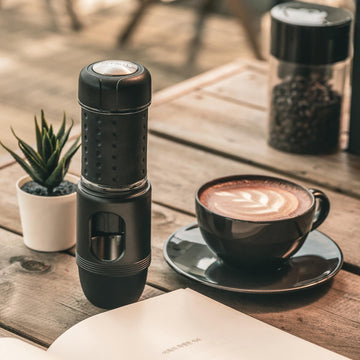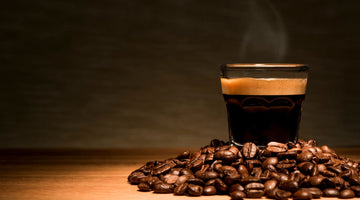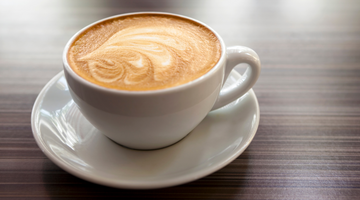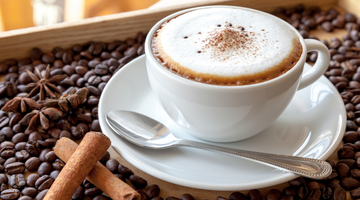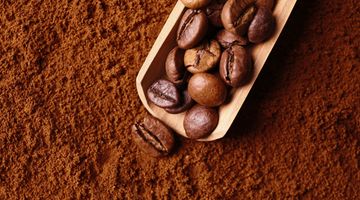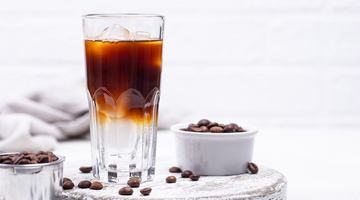You might favor one or the other or enjoy the taste of either when it takes your fancy, but what exactly is the difference between espresso and coffee? Let's allow espresso vs coffee to battle it out and find out their differences, how to make them, and the kinds of drinks you can make using each.
What are the main differences between espresso and coffee? The espresso version
The significant difference between espresso and coffee is how the beans are ground and brewed.
Essentially, all espresso is coffee, but not all types of coffee are espresso. Fun fact: In Italy, if you ask for 'un caffé' or simply a coffee, you'll receive an espresso by default.
What is espresso

What is espresso, and what makes it unique? Espresso is coffee brewed using pressure to make a delicious drink. Let's explore the rich details of this brew.
Unique brewing method
To make an espresso correctly, the method should be followed pretty rigidly, including the time it takes to 'pull' a shot, water temperature, and, of course, the grind type. Due to its complex nature, a good espresso (because who wants a mediocre one) requires high-quality equipment, especially the espresso machine.
An espresso is made by quickly forcing water through a compacted puck of finely ground coffee to extract an intense shot. A 1oz (30ml) espresso shot has a 1:2 coffee-to-water ratio and requires around 7-9g of fine grounds. The hot water should be around 194-205°F (90-96°C), and extraction should only last 22-30 seconds. Any more or less, and your espresso could be a dud.
Characteristics of espresso
Espresso is highly concentrated and has a thick, almost syrupy consistency with an intense flavor. One of its statement features is its crema. The crema is the foam layer that forms on the top of the espresso, a by-product of the high-pressure extraction. CO2 escapes the beans during extraction and settles on the top of the liquid.
What is coffee?

As mentioned at the top, espresso is coffee. Let's remove it for now and concentrate on the other brewing methods.
Brewing methods
While versatile, coffee brewing methods share a similarity. Instead of using pressure for extraction, these methods use more significant amounts of water, a coarser grind, and a longer extraction process. Drip, filter, pour-over, and cold brew all need gravity to allow hot or cold water to slowly brew. This method is called decoction and can take anywhere from 6 to 12 minutes. Since coffee tends to be a larger drink, the ground-to-water ratio is 1:18 to make a 6-8 oz drink.
Flavor and profile of coffee
Since the brewing process is slower, the results are more subtle. The color of the coffee is often lighter and brighter, as well as having more nuanced flavors.
Espresso and coffee differences - the decoction version
Coffee grinds vs espresso grinds

While the brewing method is what makes espresso and coffee different, a specific coffee grind is required for each of these processes. Since espresso is a fast, pressurized extraction, the grind must be fine to allow the water to push as much flavor from the grinds as possible in a short time. With coffee, filter, drip, you name it; the grinds are much coarser and don't need to be as refined as espresso. The extraction process is slower, and the water has more time to extract the grinds.
Coffee vs espresso brewing method
Since the coffee brewing method is at the mercy of gravity, the process is much slower. Espresso is a fast, high-pressure process that creates a uniquely intense drink.
Flavor differences between espresso and coffee
Espresso's flavors are incredibly concentrated and intense, which is why many people might find it too strong. However, coffee brewed in a French press or pour-over produces more subtle flavors due to its high water ratio.
Coffee and espresso serving size

Espresso is commonly served as a single 1oz (30ml) shot or a double 2oz (60ml) shot, while coffee tends to come in a larger 6-8 oz serving.
Espresso vs coffee caffeine levels
Many coffee drinkers tend to choose espresso over coffee as they believe it has more caffeine. However, this isn't strictly true. A 1oz espresso has around 63 mg of caffeine, while a 1oz coffee only has 12mg. But, due to the size of a typical coffee of 8oz, there's actually more like 96g of caffeine in coffee. Of course, if you're downing multiple espresso, prepare for the buzz.
Coffee vs espresso beans
While you can get specific 'espresso' beans that are dark roasted, you can, in fact, use any bean or roast to make espresso. In Italy, dark roasts are popular, but all coffee beans are one of two variants, Robusta or Arabica. It isn't the bean but the brew that makes espresso what it is.
How to make espresso anywhere
While it's fair to say that making espresso is an art form, let's talk about how to make espresso at home or away!
Espresso-making equipment
-
Espresso machine (try the STARESSO Classic)
-
Coffee beans
-
Scales, or spoon
-
Burr Grinder
-
Tamper
-
Cup or shot glass
Step-by-step espresso brewing instructions

Grind Your Coffee: Use a burr grinder to grind coffee beans to a fine consistency. The grind should be similar to table salt.
Preheat your portable espresso machine: Fill the water reservoir of the STARESSO Classic with hot water and pump the machine a few times to preheat it. This helps maintain a stable brewing temperature. Ensure all components are securely connected.
Distribute the coffee: Measure out the appropriate amount of coffee grounds for a single or double shot of espresso, typically around 7-9 grams for a single shot and 14-18 grams for a double shot.
Tamp the coffee: Use the provided tamper or your fingers to firmly and evenly tamp the coffee grounds down in the portafilter.
Fill the water tank: Fill the water tank with hot water to the desired level, depending on how strong you want your espresso.
Assemble and pump: Attach the portafilter to the machine, ensuring it's securely in place. Begin pumping the machine to generate pressure. The pressure will force hot water through the coffee grounds, extracting the espresso.
Monitor extraction: Watch as the espresso is extracted into your cup. For a single shot, the extraction process should take 25-30 seconds.
How to brew coffee
Brewing coffee can be a simple or intricate process, depending on your preferred method and the tools you have available.
Grind your coffee beans: Use a burr grinder to grind the coffee beans just before brewing. The grind size will depend on your brewing method. For drip coffee, a medium grind is usually ideal.
Measure your coffee: Determine the coffee-to-water ratio based on your taste preferences and your brewing method. A standard ratio is around 1-2 tablespoons of coffee per 6 ounces of water.
Boil water: Heat filtered water to the appropriate temperature for your brewing method. For most methods, water between 195°F and 205°F (90°C to 96°C) is ideal. If you don't have a thermometer, bring the water to a boil and wait for about 30 seconds before using it.
Preheat your equipment: Preheat your brewing equipment to help maintain the temperature of the coffee during brewing. This is especially important for methods like pour-over and French press.
Brewing Methods:
-
Drip Coffee: Place a filter in your drip coffee maker, add the grounds, and pour the hot water over them. Let the water drip through the coffee grounds into the carafe below.
-
French Press: Add the ground coffee to the French press carafe, pour in the hot water, and stir gently. Put the lid on the French press with the plunger up and let the coffee steep for about 4 minutes. Slowly push down the plunger to separate the grounds from the brewed coffee.
-
Pour-Over: Place a filter in the pour-over cone or dripper, add the ground coffee, and slowly pour hot water over the grounds in a circular motion, beginning from the middle and moving outward. Let the water to drip through the coffee grounds into your cup or carafe below.
-
Aeropress: Place a filter in the Aeropress cap, add the ground coffee to the chamber, pour in hot water, and stir gently. Attach the cap with the filter, let the coffee steep for about 1 minute, then press down the plunger to extract the coffee.
Popular espresso and coffee drinks
Once a coffee or espresso is made, it can become the base for other coffee drinks or even cocktails. Espresso is versatile enough to be customized in both simple and extravagant ways, from simply adding milk to cream foams and flavorings.
Espresso-based drinks

Some popular espresso-based drinks include cappuccino, lattes, americano and macchiatos. With espresso as the base, the flavor is still rich, even when combined with other flavors. Here are some of the basic differences between espresso drinks.
-
Americano: Made by diluting a shot of espresso with hot water, resulting in a milder flavor similar to drip coffee.
-
Cappuccino: A classic Italian drink with equal parts espresso, steamed milk, and foam. It's typically served in a smaller cup.
-
Latte: This drink consists of a shot of espresso, a more considerable amount of steamed milk, and a thin layer of foam on top. It's often served in a larger cup.
-
Macchiato: "Macchiato" means "stained" or "marked" in Italian. A traditional macchiato is made by adding a small amount of steamed milk or milk foam to a shot of espresso.
-
Flat White: This drink is similar to a latte but with a higher coffee to milk ratio and a velvety microfoam texture. It originated in Australia and New Zealand.
-
Mocha: This drink combines espresso with steamed milk, chocolate syrup, and whipped cream, creating a rich and indulgent combination.
-
Affogato: A dessert-style drink consisting of a shot of hot espresso over vanilla ice cream or gelato.
Coffee drink variations

-
Drip Coffee Maker: An automatic coffee maker or machine, this method involves pouring water over ground coffee beans in a filter. The water drips through the grounds and into a carafe below. This is the most common method of coffee in most American households.
-
French Press (Press Pot): Steep coarsely ground coffee in hot water for several minutes before pressing down a plunger to separate the grounds from the brewed coffee.
-
Pour-Over (Manual Drip): Pour hot water over coffee grounds in a filter cone or dripper. The water drips through the grounds and into a container below.
-
Aeropress: A device that uses air pressure to force hot water through coffee grounds. It combines elements of immersion and pressure brewing methods.
-
Moka Pot (Stovetop Espresso Maker): This is a stovetop coffee maker that works by passing boiling water pressurized by steam through ground coffee.
-
Cold Brew: Steep coarsely ground coffee in cold water for an extended period (usually 12-24 hours) to extract flavors. Dilute with water or milk before serving over ice.
-
Siphon (Vacuum Pot): Uses a vacuum process to brew coffee by heating water in a bottom chamber, causing it to rise and mix with coffee grounds in an upper chamber. Once removed from heat, the brewed coffee is pulled back down into the bottom chamber.
-
Chemex is a pour-over brewing method that uses a special hourglass-shaped glass vessel with a thick paper filter. Hot water is poured over coffee grounds in the filter, and the brewed coffee drips into the bottom of the vessel.
Frequently asked questions about the differences between espresso and coffee
Does espresso have more caffeine than coffee?
Nope. Based on the standard serving size of each, coffee has more caffeine than espresso. A single 1oz espresso shot has 63mg of caffeine, while a 1 oz serving of coffee has 12 mg. But, since coffee tends to be in a larger serving of 6-8oz, a cup has more caffeine.
Is espresso a coffee?
Yes! All espresso is coffee, but not all coffee can be considered espresso. Espresso is simply a coffee brewing method.
